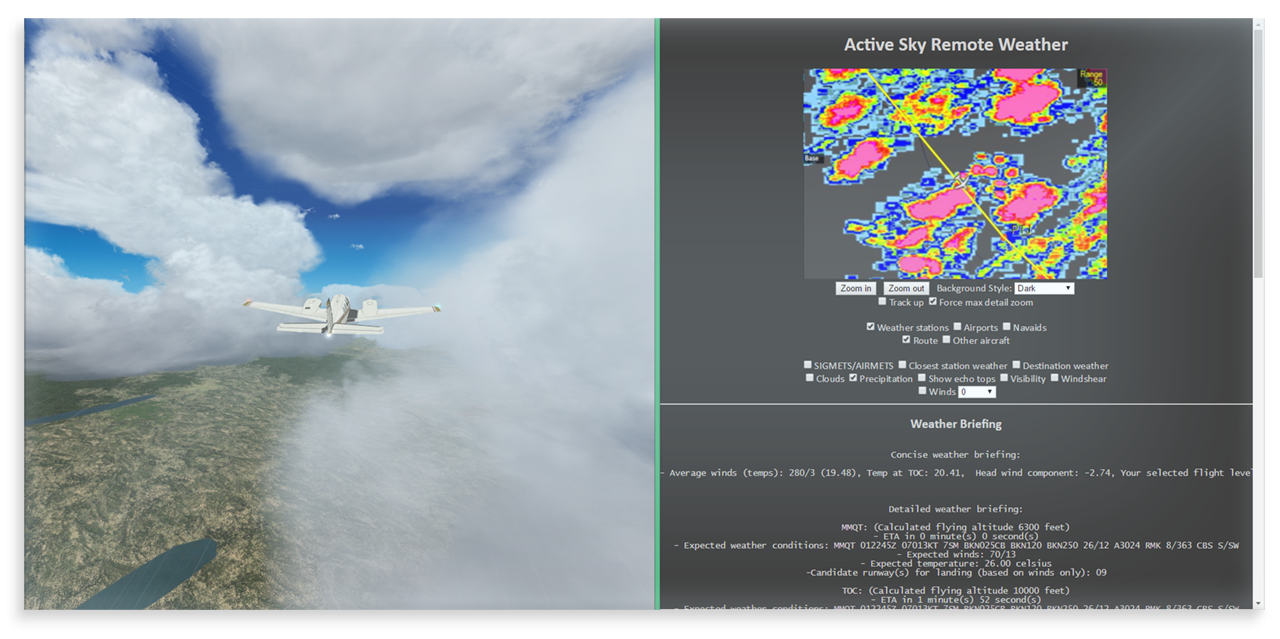
While planning your flight in the UI, your entire route is available as voice in the Briefing screen. The voice briefing will inform you of these changes.

What you thought was a benign route when you took off may have TS or turbulence show up along the way. If the flight is over an hour long, it's not unusual for weather to change along your flight. One of the advantages of the route report is weather in ASN is not static. If your flight plan is a long one the report can take a while to read through. Using your radio panel, tune to 122.0 get get a voice report from the closest active station that is not too old (less than 2 hours.)ġ22.02 to get conditions at your destination.ġ22.05 to get a report on your whole flight plan. You must have a flight plan filed in ASN to get route and destination. Similar to AS2012, ASN provides three frequencies you can tune to in the aircraft to get voice descriptions of weather conditions during your flight. This is very helpful when you want to be able to pause or restart the sim and keep ASN from advancing in real time and eliminate the need to manually reset the time in ASN. When using this, ASN will sync to the time in FSX and not display weather metars beyond this time. You will not be able to recapture the experience these extreme weather reports provide.Ī useful feature of the Historical Mode is the lock to sim time checkbox. If your flight routes are usually strongly influenced by these reports, your historical weather will more strongly based on metars and your flight plan. Since ASN is a new product and high altitude is not included in Metars, your high altitude portion of the flight will likely vary from what you have experienced flying this same time in other weather generators.Īt this time, SIGMETS, AIRMETS and PIREPS are not included in historical data on the AS servers or saved files. In Historical Mode, by setting a date, ASN will use meters saved on the ASN weather severs up to three years old.īe aware this uses METAR data so is based on ground observations (Temp, Pressure, clouds, winds and comments.)

More often, I will import FPs created with other tools, then use the insert if I need to enhance the briefing with more details.ĪSN has two ways to fly weather in the past:Ģ) Using Historical Mode, set a date and time. Note: Although the ASN Flight Planner is useful if you just want to generated a quick, simple plan on the fly, it does not have SIDs, STARS, or 5 letter waypoints. Might contain turbulence, freezing or mountain obscuration. I find this handy when I want to see additional weather details along the route including altitudes I might climb or descend through which In the Briefing screen, you will see your new WP inserted into the briefing with weather details at that location.

While displaying a plan, insert a WP no closer than 15 miles from departure or destination. This is useful if the navigation points are sparse along your route or widely spaced. If you do this WITHOUT modifying your navigation version of the plan, it becomes an enhancement which does not affect navigation. If you do this BEFORE saving the plan to be used in your plan's navigation program, the inserted point become part of the navigation. An option menu provides options for inserting a new waypoint. The map screen will display with the location centered. With the navigation list displayed in the planner, double-click one of them. Not only can ASN create simple flight plans from scratch, but you can use insert tools to enhance the generated or imported plan.


 0 kommentar(er)
0 kommentar(er)
